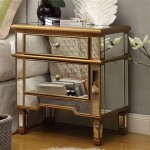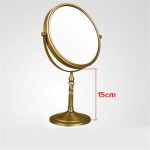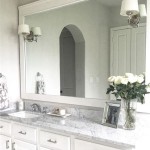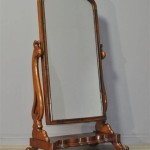How To Hang A Mirror On A Wall Without Nails
Hanging a mirror is a common home decorating task. It can brighten a room, create the illusion of more space, and add a touch of style. Traditional methods often involve nails or screws, which can damage walls and require tools. However, several methods exist for hanging mirrors without resorting to these intrusive techniques. This article outlines various approaches to securely mount a mirror on a wall, minimizing potential damage and simplifying the installation process.
Selecting the Right Adhesive for the Job
The first and most crucial step in hanging a mirror without nails is selecting the appropriate adhesive. Not all adhesives are created equal, and using the wrong one can lead to the mirror falling and potentially causing damage or injury. Several factors influence the choice of adhesive, including the weight of the mirror, the surface it will be attached to, and the desired permanence of the installation.
Mirror mastic is a specialized adhesive specifically designed for bonding mirrors to various surfaces. It provides a strong and durable bond that can withstand the weight of most mirrors. Unlike general-purpose adhesives, mirror mastic is formulated to prevent damage to the mirror's backing, which can occur with certain chemical compounds. It is important to read the manufacturer's instructions carefully before using mirror mastic to ensure proper application and curing.
Construction adhesive offers a versatile alternative for hanging mirrors without nails. These adhesives are designed for a wide range of building and repair applications, and many are suitable for bonding mirrors to walls. Ensure the selected construction adhesive is explicitly labeled as safe for use with mirrors to avoid damaging the backing. Look for adhesives that offer a high initial grab, which helps to hold the mirror in place while the adhesive cures.
Double-sided mounting tape is a convenient option for hanging smaller, lightweight mirrors. This type of tape features adhesive on both sides, allowing it to bond directly to both the mirror and the wall. Choose a mounting tape specifically designed for heavy-duty applications and capable of supporting the weight of the mirror. Thoroughly clean both surfaces before applying the tape to ensure optimal adhesion.
Consider the wall surface when selecting an adhesive. Smooth, non-porous surfaces like tile or glass generally provide a better bond than textured or porous surfaces like drywall or plaster. If the wall surface is painted, ensure the paint is clean and free of loose flakes or debris. In some cases, it may be necessary to prime or seal the wall surface to improve adhesion.
Preparing the Wall and Mirror Surface
Proper preparation of both the wall and mirror surfaces is essential for a successful and secure installation. This step involves cleaning the surfaces to remove any dirt, dust, or grease that could interfere with the adhesive bond. Neglecting this step can significantly reduce the adhesive's effectiveness and increase the risk of the mirror falling.
Start by cleaning the wall surface with a mild detergent and water. Use a clean cloth or sponge to wipe down the area where the mirror will be hung. Pay particular attention to any areas that may be greasy or oily. Rinse the wall with clean water and allow it to dry completely before proceeding. For particularly stubborn dirt or grime, a degreasing cleaner may be necessary.
Next, clean the back of the mirror with a similar solution of mild detergent and water. Carefully wipe down the surface to remove any dust or debris. Avoid using abrasive cleaners or scouring pads, as these can scratch or damage the mirror's backing. Rinse the mirror with clean water and allow it to dry completely before applying any adhesive. A lint-free cloth can help prevent streaks and water spots.
Once both surfaces are clean and dry, consider lightly sanding the back of the mirror with fine-grit sandpaper. This will create a slightly rougher surface that the adhesive can grip more effectively. Be careful not to apply too much pressure, as this could damage the mirror's backing. After sanding, wipe away any dust with a clean, dry cloth.
For added security, consider applying a primer or sealant to the wall surface before applying the adhesive. This can help to improve adhesion, especially on porous surfaces like drywall or plaster. Choose a primer or sealant specifically designed for use with adhesives. Allow the primer or sealant to dry completely before proceeding with the installation.
Applying the Adhesive and Hanging the Mirror
With the adhesive selected and the surfaces properly prepared, the next step involves applying the adhesive and hanging the mirror. This process requires careful attention to detail to ensure the mirror is securely mounted and properly aligned. Follow the manufacturer's instructions for the chosen adhesive and take precautions to avoid making mistakes that could compromise the installation.
If using mirror mastic or construction adhesive, apply the adhesive to the back of the mirror in vertical beads or strips. Space the beads or strips evenly apart to ensure the weight of the mirror is distributed evenly. Avoid applying adhesive too close to the edges of the mirror, as this can cause it to squeeze out when the mirror is pressed against the wall. The manufacturer's instructions will specify the recommended amount of adhesive to use based on the mirror's size and weight.
If using double-sided mounting tape, cut the tape into appropriate lengths and apply it to the back of the mirror in strips or squares. Again, space the tape evenly apart to distribute the weight of the mirror. Ensure the tape is firmly pressed onto the mirror's surface to ensure a strong bond. Peel off the protective backing from the tape before attaching the mirror to the wall.
Carefully position the mirror on the wall, ensuring it is level and aligned correctly. Use a level to check the alignment and make any necessary adjustments before pressing the mirror firmly against the wall. Once the mirror is in place, apply firm and even pressure across the entire surface to ensure the adhesive bonds properly. Hold the mirror in place for the amount of time recommended by the adhesive manufacturer.
For larger or heavier mirrors, consider using temporary supports to hold the mirror in place while the adhesive cures. These supports can be simple props or commercially available clamps designed for this purpose. The supports will help to prevent the mirror from sliding or falling while the adhesive sets. Remove the supports once the adhesive has fully cured, as indicated by the manufacturer's instructions.
After the adhesive has cured, inspect the installation to ensure the mirror is securely mounted. Gently tug on the mirror to check for any signs of weakness or instability. If the mirror feels loose or wobbly, it may be necessary to apply additional adhesive or reinforce the installation with mechanical fasteners. Regular inspection of the mirror's mounting is recommended to ensure its continued security.
In cases where the wall surface is particularly weak or unstable, it may be necessary to use a combination of adhesive and mechanical fasteners to ensure the mirror is securely mounted. This approach involves using adhesive to provide a strong initial bond and then supplementing it with screws or anchors for added support. However, this method requires drilling into the wall and may not be suitable for all situations.

3 Simple Ways To Hang A Mirror On Wall Without Nails Wikihow

How To Hang A Mirror On Wall Without Nails

How To Hang A Heavy Mirror In 5 Simple Steps

How To Hang A Mirror On Wall Without Nails Guide For All Diyers

How To Hang A Heavy Mirror At Home

3 Simple Ways To Hang A Mirror On Wall Without Nails Wikihow

3 Simple Ways To Hang A Mirror On Wall Without Nails Wikihow

3 Simple Ways To Hang A Mirror On Wall Without Nails Wikihow

Hanging A Heavy Mirror Picture Without Studs Pictures

3 Simple Ways To Hang A Mirror On Wall Without Nails Wikihow








